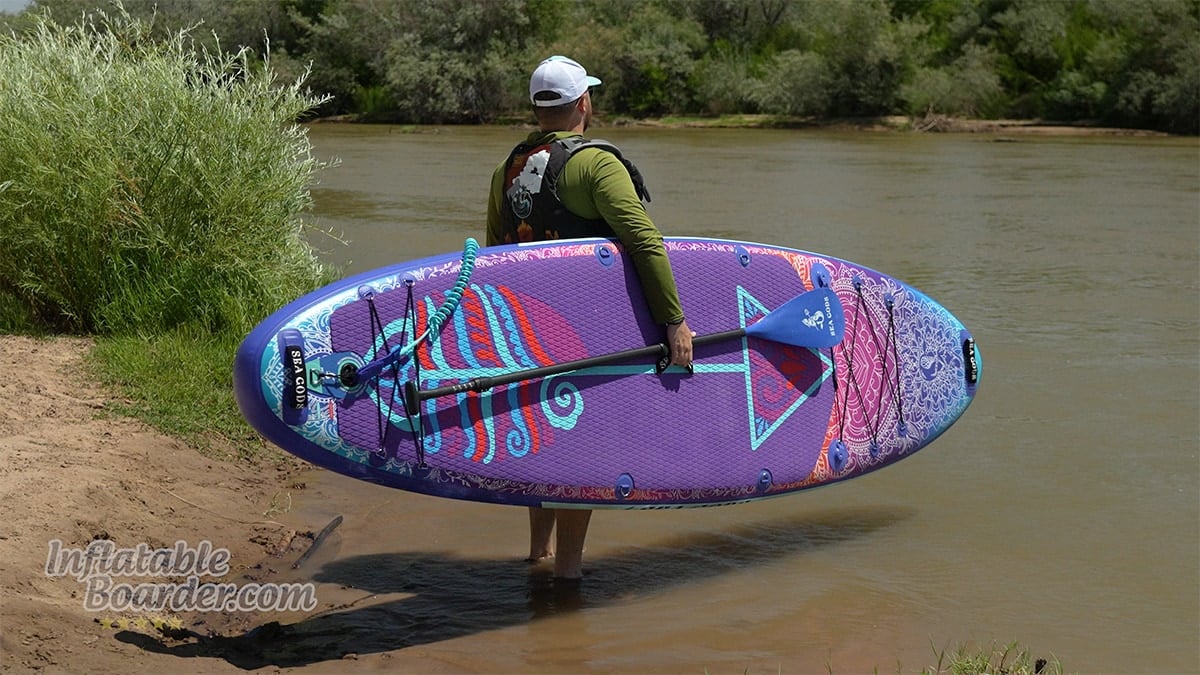
Sea Gods Diatom Ten6 CX iSUP: Overview
The Sea Gods Diatom Ten6 CX blends the new lightweight and rigid CX construction with the stable shape and eye-catching design of the original Diatom Ten6 (now the Diatom Ten6 ULF). The new materials and construction keep the Diatom Ten6 CX extra stiff and plenty stable for paddling, fishing, sun salutations, or even catching the occasional wave. If you like to paddle with a pet or child, are a larger paddler, or just like to have extra room and stability on your all-around iSUP, you’re going to love the Sea Gods Diatom Ten6 CX.
— Sea Gods Diatom Ten6 CX Summary Ratings and Review —
Sea Gods Diatom Ten6 CX
-
Construction & Durability
-
Features and Versatility
-
Stability
-
Speed
-
Maneuverability
-
Tracking
Overall Score
The Sea Gods Diatom Ten6 CX is a beautifully designed all-around iSUP with excellent stability and maneuverability.
Pros
- Beautiful design turns this iSUP into a work of art
- Rigid construction with advanced drop stitch inner core
- Lightweight fusion PVC outer shell
- Durable heat-molded seams with double-reinforced rail layers
- Excellent stability
- Extremely maneuverable
- High quality accessories and rolling backpack
- Lifetime warranty
Cons
- While extremely maneuverable, the Diatom Ten6 CX does struggle to track straight over longer distances
- The pintail shape is great for catching the occasional wave, but reduces stability when standing or sitting near the tail of the board
Sea Gods Diatom Ten6 CX iSUP Video Review
Construction and Durability
The Diatom Ten6 CX is made with Sea God’s Cross Weave (CX) Ultralight Fusion materials and processes. These newer materials help reduce board weight without sacrificing rigidity or durability.
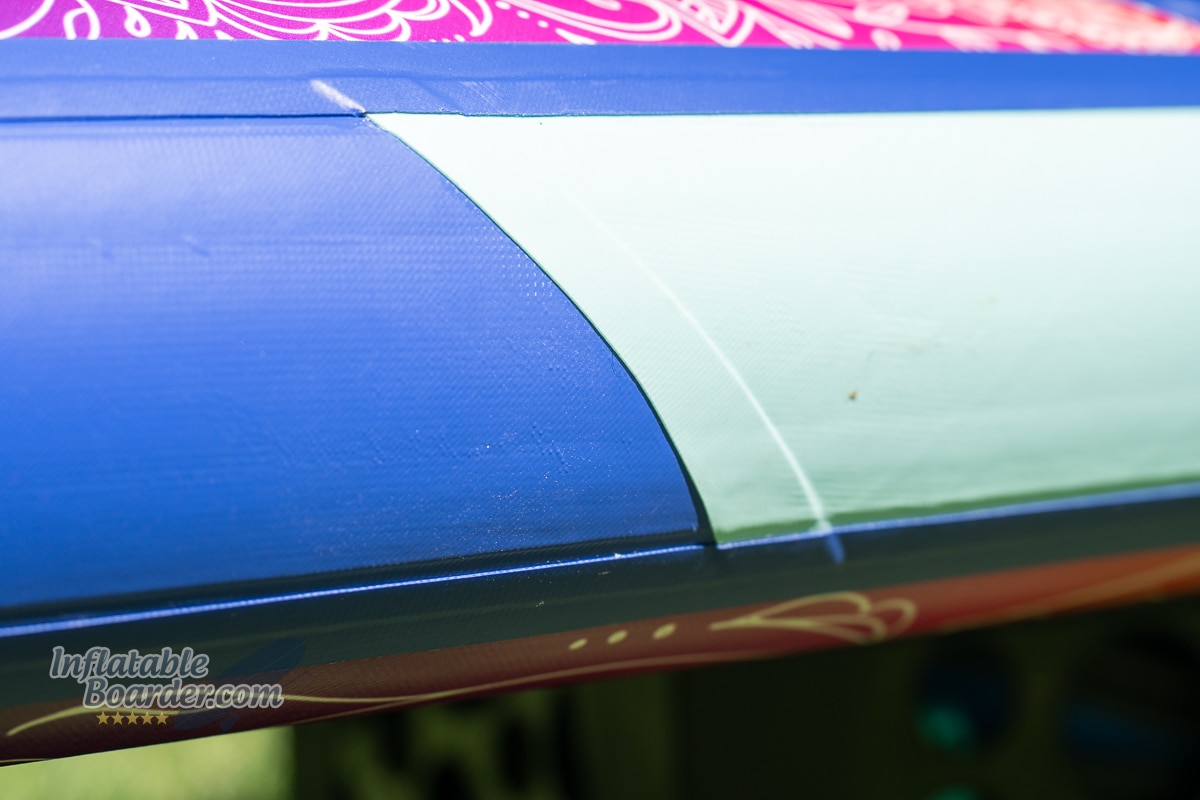
Inside the Diatom CX is a drop stitch fabric core that gives the board its shape and rigidity. While this is true for all inflatable stand up paddleboards, not all drop stitch cores are the same. Sea Gods’ new CX construction uses a woven fabric material for the top and bottom base layers rather than a traditional knitted fabric. This reduces weight by using less material, but also reduces the amount the material can stretch when under a load. There are thousands of yarns stitched between the two layers of fabric that keep the two layers separated at the same distance throughout the board once inflated. Again Sea Gods has broken from the norm by using a crossing drop stitch pattern rather than the traditional V-stitch pattern. This again helps increase rigidity without adding additional weight.
The outer PVC shell of the Diatom is made of a 1.7mm thick reinforced PVC tarpaulin that is fused directly to the inner core of the board. Fusion construction uses high heat and pressure to slightly melt the PVC material into the fabric layer and create a mechanical bond rather than relying on layers of glue to laminate the board together. Once the top and bottom layers are laminated and cut to shape, the edges of the board are brought together and sealed with a layer of PVC material that is heat-molded to the board. The heat molding process uses a combination of glue, heat, and pressure to pre-stretch the pvc fabric and bond it together to eliminate any post-construction stretching at the seams.
An outer rail layer of PVC is applied all around the side of the board to protect the inner rail layer. Lastly two rail reinforcement strips, or pin lines, are adhered to the edges of the outer rail layer to protect the edges from impact and abrasion.
After the deck pad and all other on-board features are installed, the Diatom CX weighs in at just 19 lbs on our scale, and has a recommended maximum inflation pressure of 20 PSI.
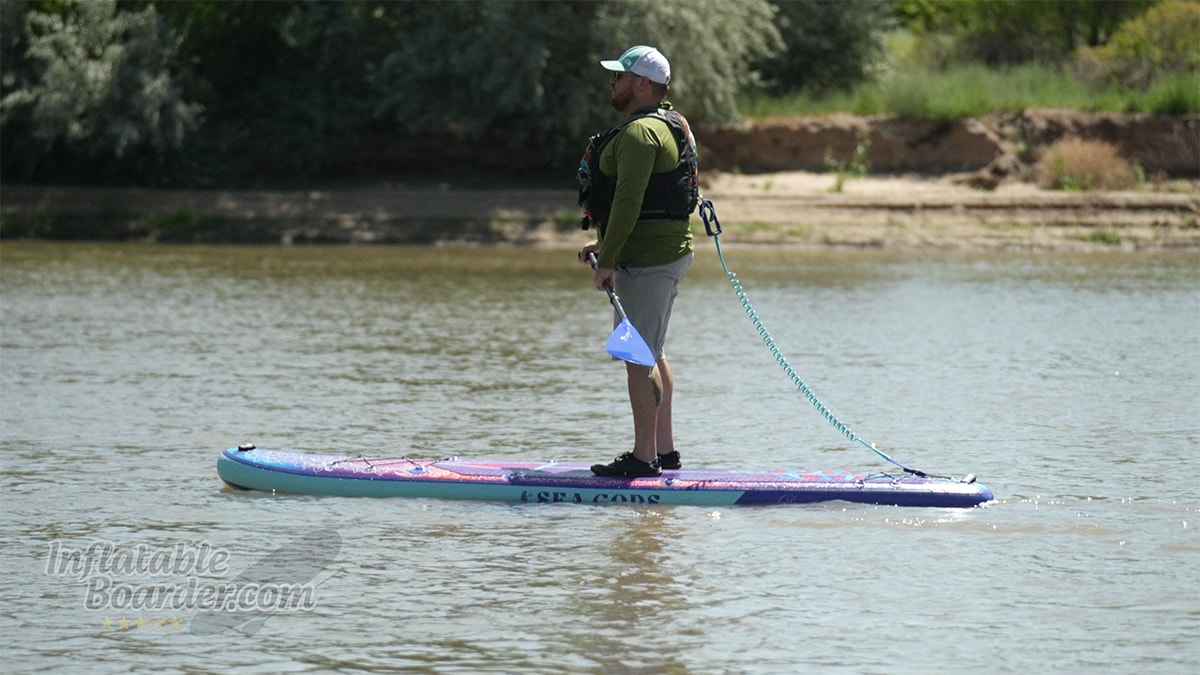
With a lightweight construction there’s always a bit of a worry that the board’s rigidity may take a hit, even when built with higher-end materials. We put the Diatom CX to the test in our 170-pound static bend evaluation. Across a 7’ span, the Diatom CX bent just 1.3” (3.1 cm) when loaded with 170 pounds of weight at the standing area when inflated to 20 PSI. That is significantly more stiff than our current running average of 1.55”, and is essentially as stiff as the much heavier (24 lbs) Diatom Ten6 ULF.
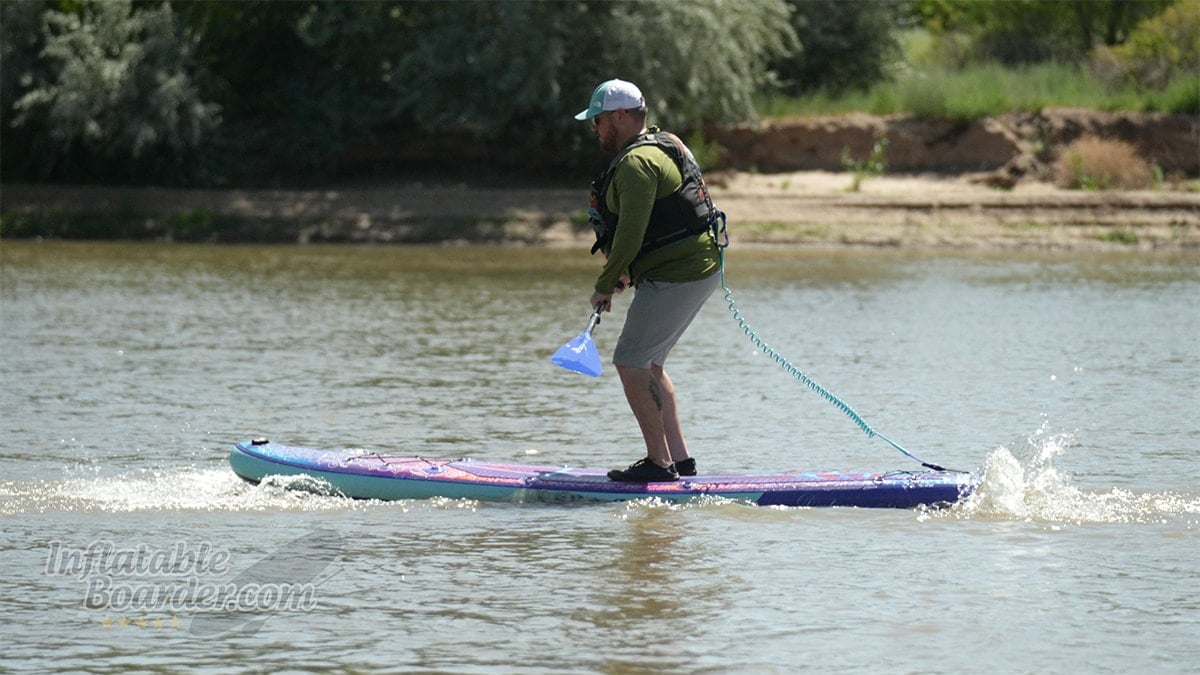
Measuring rigidity only gives us one view of board stiffness. The more important factor is how it feels on the water. While standing and paddling normally on the Diatom CX I couldn’t feel any noticeable flex in the board. It feels great under my feet. As I started bouncing on the board I did feel a mild-to-moderate amount of flex, but once I stopped it had a very short-lived rebound. The rebound did feel a little “tight” but not so much that I would call it bouncy. During sprint paddling I could feel a little bit of the flex, but it was very minimal.
Overall the Sea Gods Diatom Ten6 CX is very stiff when fully inflated.
Specifications
| Dimensions | |
| Length | 10’ 6” |
| Width | 34“ |
| Thickness | 6“ |
| Weight | |
| Max Capacity | 340 pounds |
| Board Weight | 19 pounds |
| Kit Weight |
29 pounds |
| Buying Info | |
| List Price | $ |
| Warranty | 10 years |
| Returns period | 30 days |
Features, Accessories and Versatility
It can be hard to focus on the individual features of the Diatom Ten6 CX because it’s just so freaking awesome looking. But they are there! The Diatom CX is kitted out to be a fully-versatile all-around iSUP.
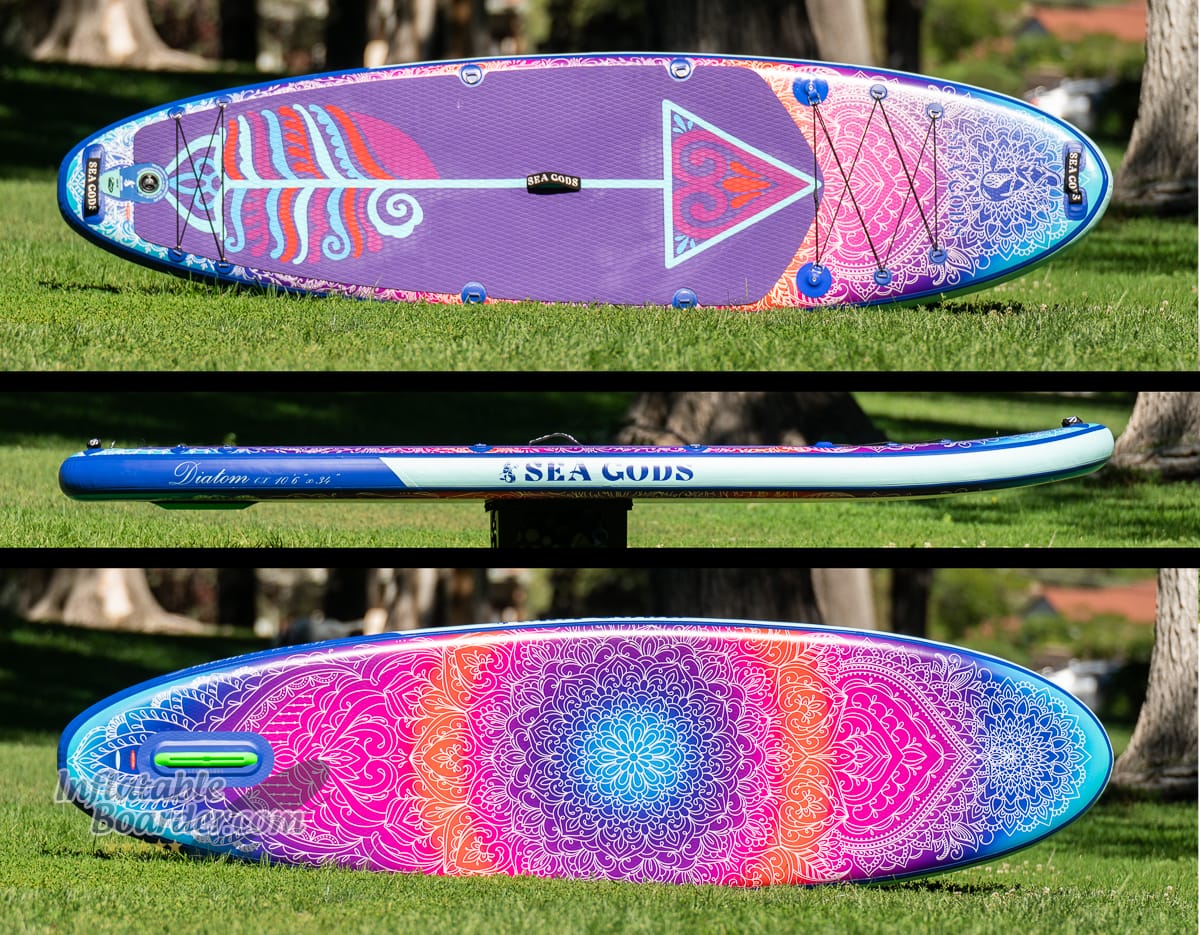
The mandala design of the Diatom CX comes from award-winning artist Jamie Locke from my home town of Indianapolis, Indiana. Jamie specializes in carved mandala designs and murals. Her goal is to “create art that uplifts and inspires,” and I know that I certainly feel uplifted every time I see the Diatom CX. This design is definitely my vibe.
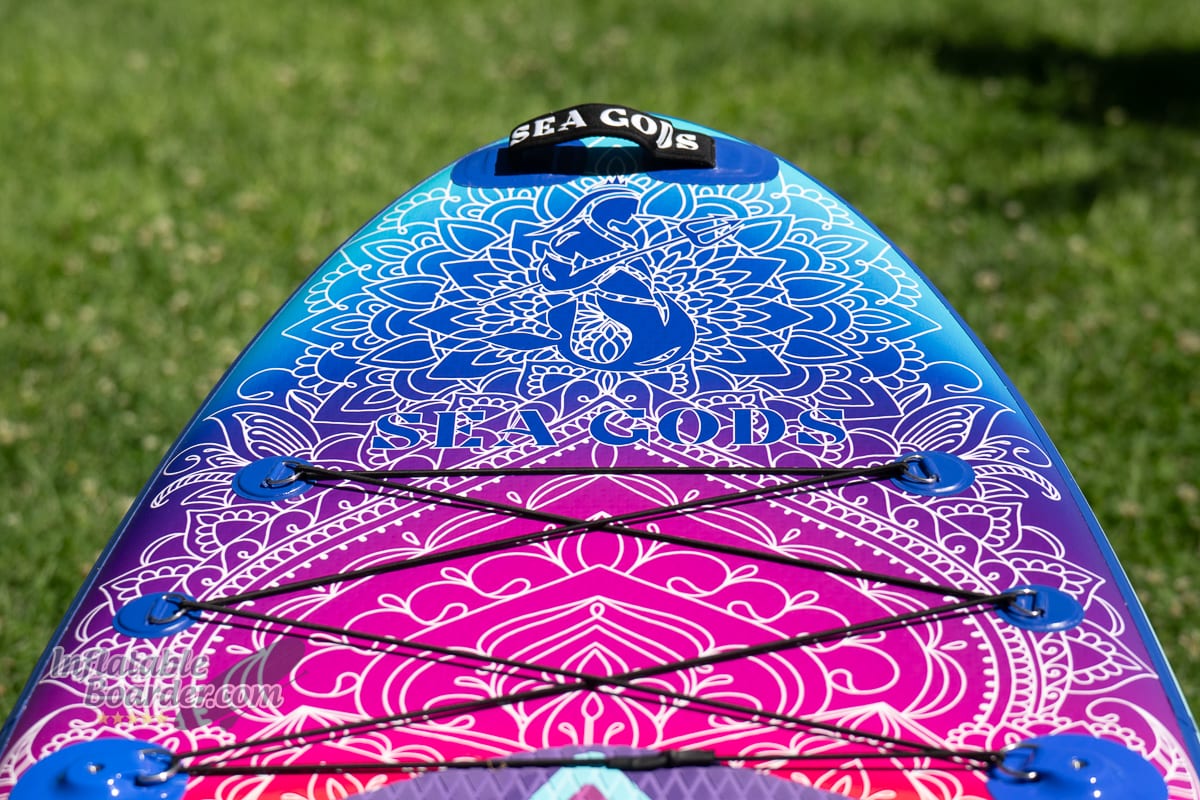
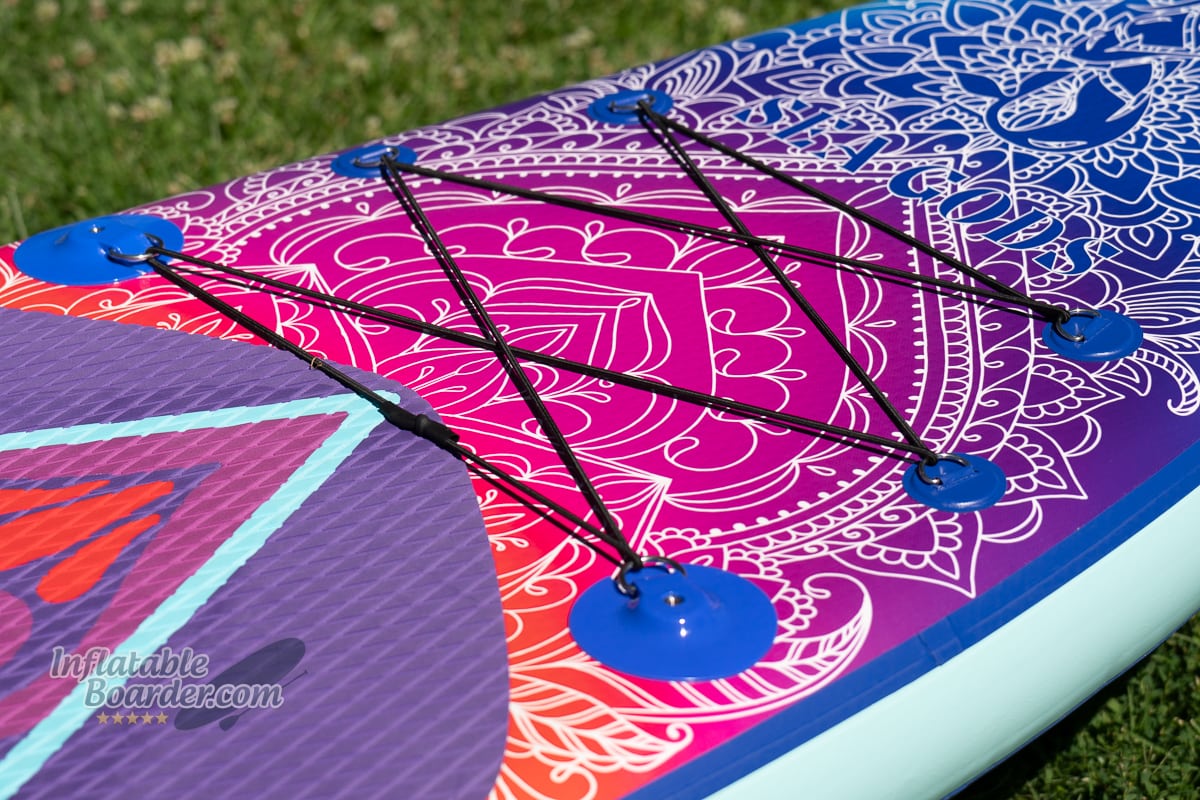
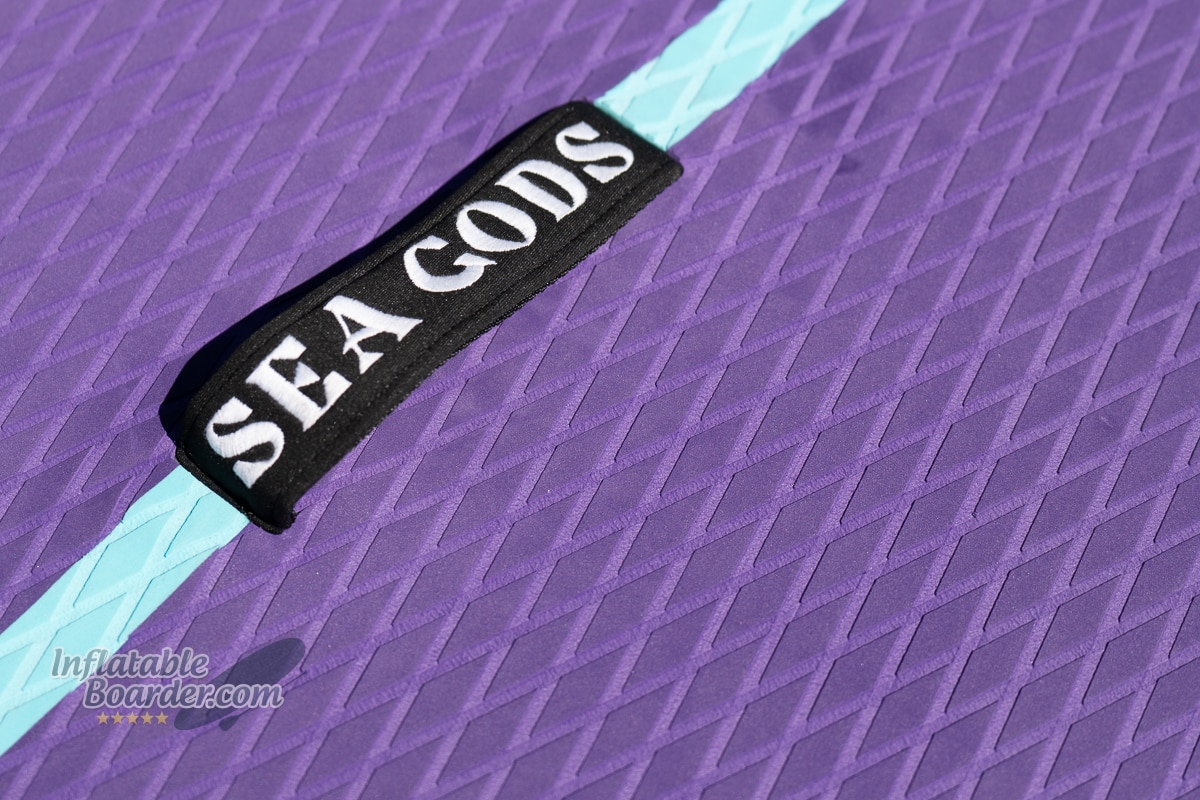
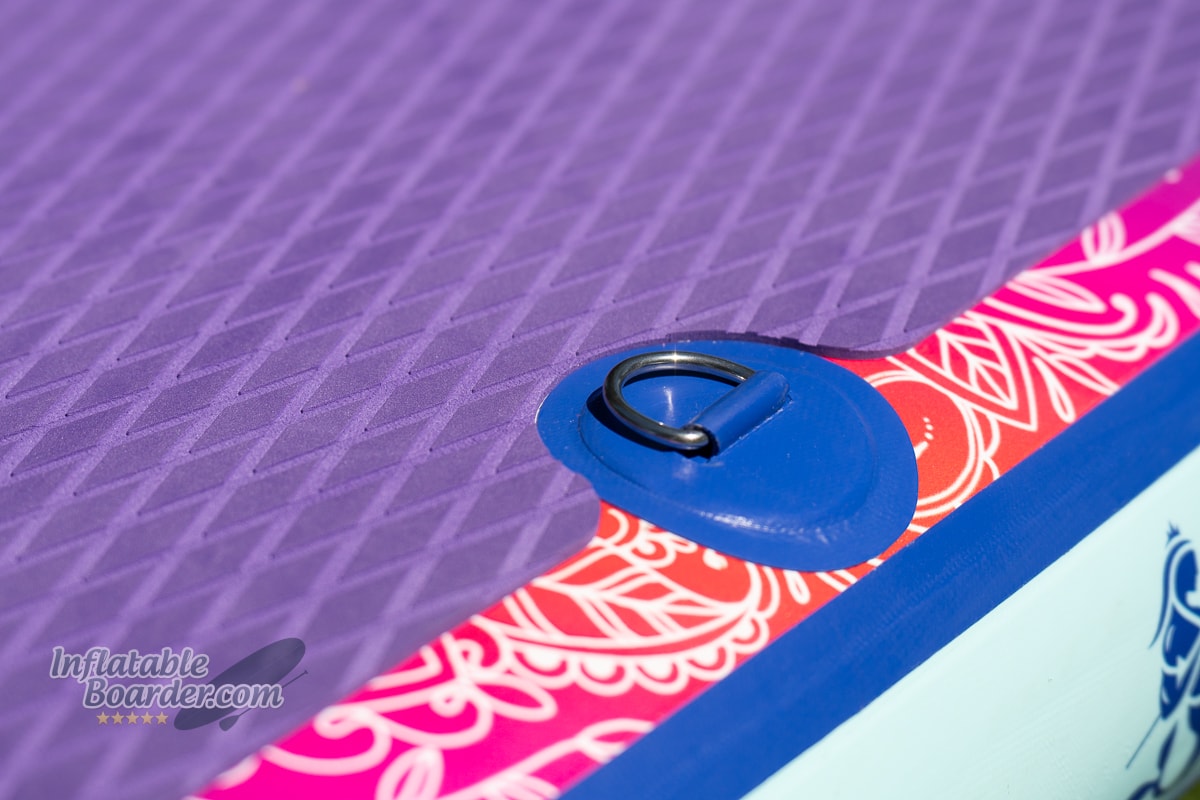
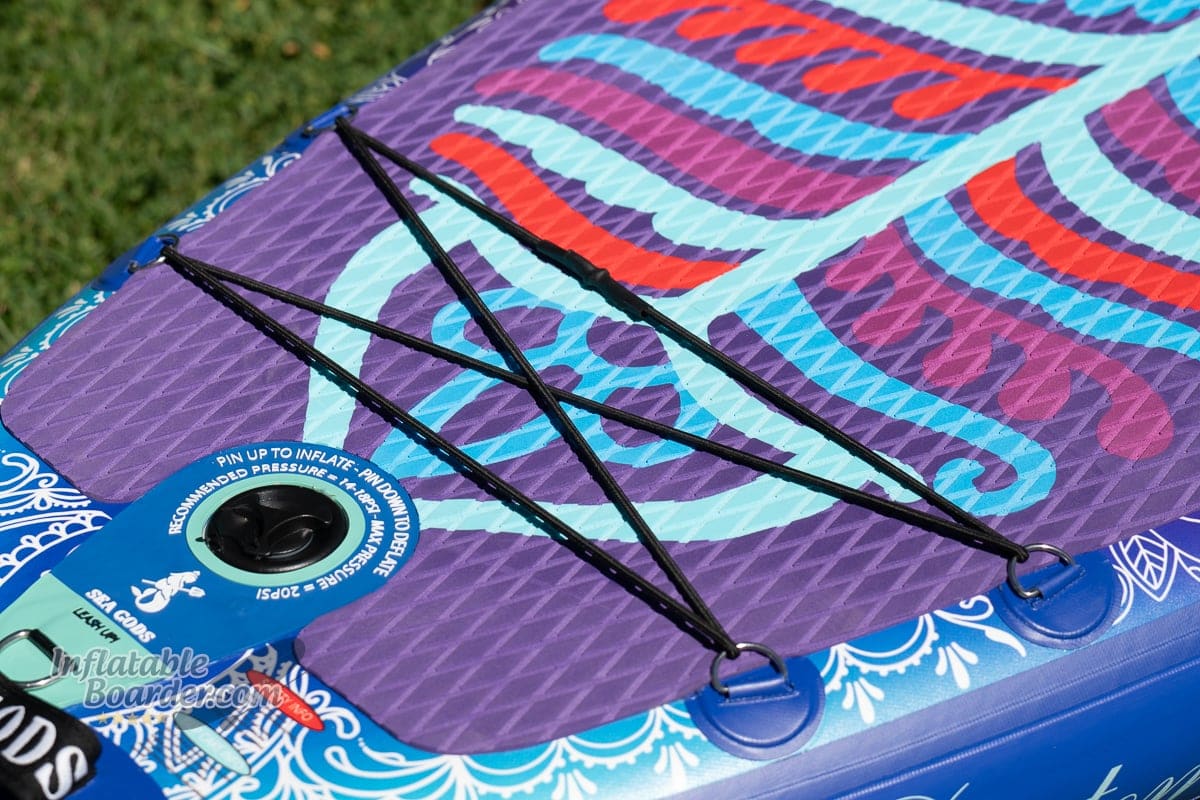
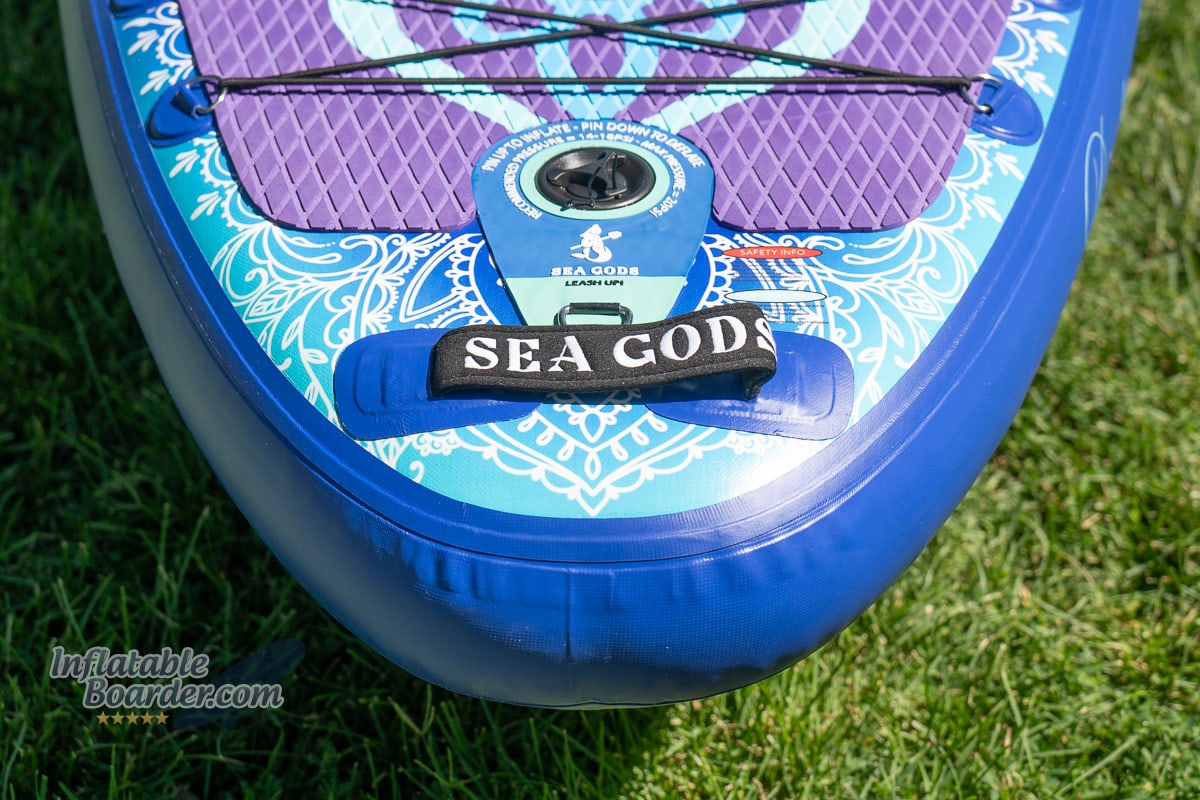
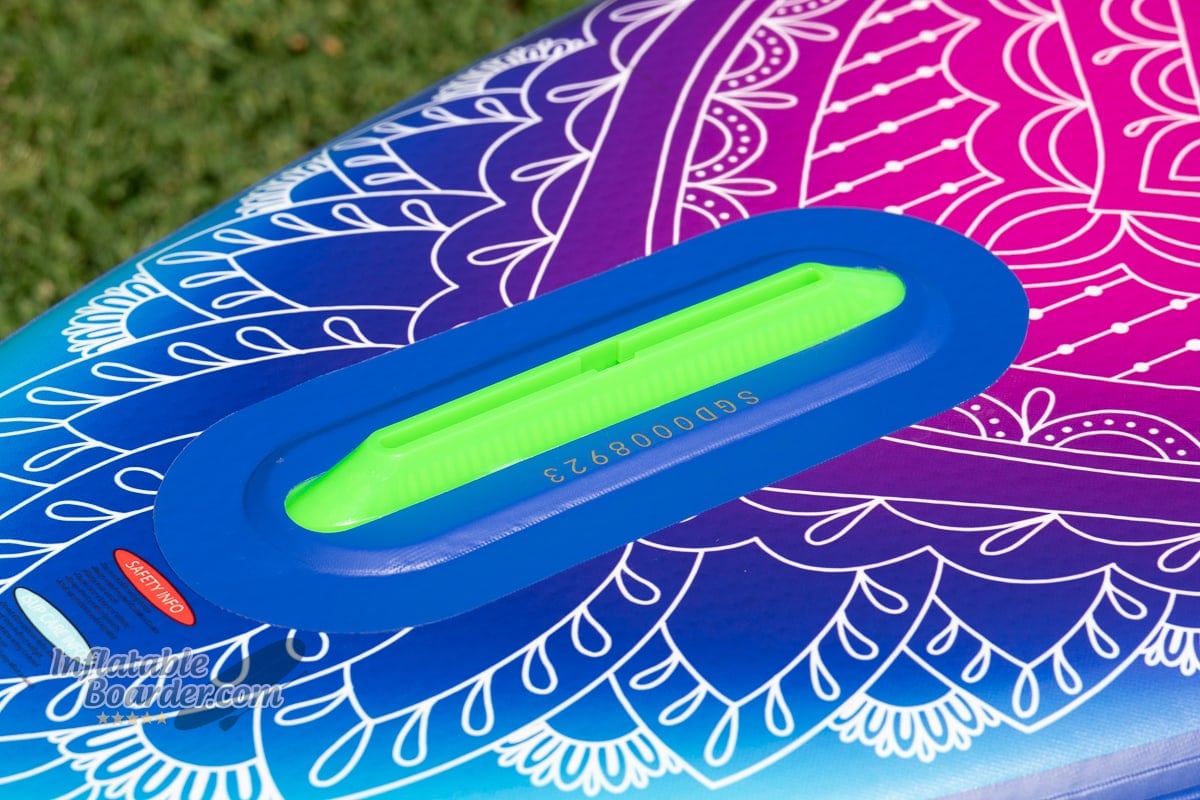
The Diatom Ten6 CX’s onboard features make it highly versatile. You can load up the front with cargo for a long day on the water, attach a fishing pole (or two), paddle with a pet or friend, stretch out for some yoga, and even try out some SUP surfing.
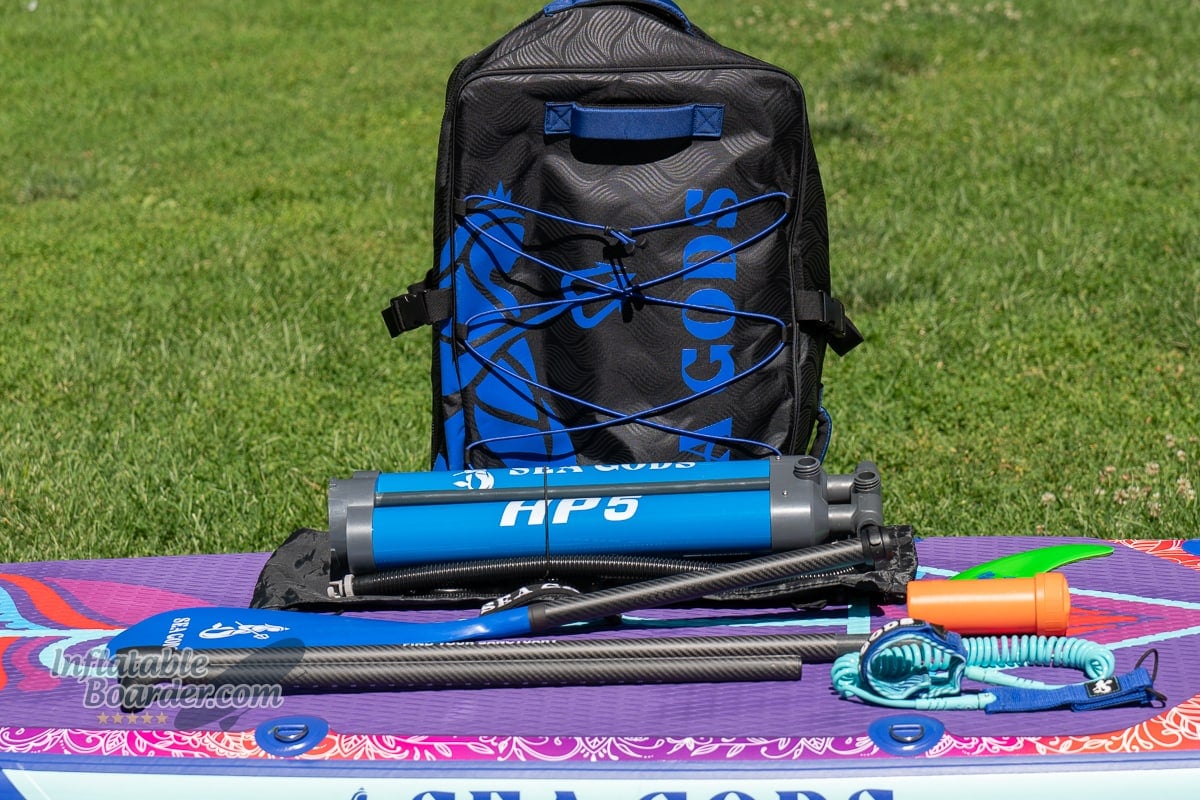
Included with the Diatom Ten6 CX iSUP is the Sea Gods carbon fiber paddle (more on that in a bit), a coiled ankle/calf leash, 9” surf-style fin with tool-less Kumano click inserts for easy installation, a double-chamber/triple action hand pump, a heavy duty storage bag, and repair kit. The Bag has both a well-padded backpack harness and high-quality wheels for easy carrying wherever you go.
Diatom Ten6 CX “Mandala”
The Sea Gods Diatom Ten6 CX is also available in a second design – the “Mandala.” This is the same mandala board artwork but with a unique carved deck pad, new fin box, and updated accessory kit.

The deck pad on the Diatom CX Mandala also gets an update. Rather than a diamond-groove deck pad texture, the new pad is made of two layers of EVA foam with the top layer CNC-milled away to create a 3-D mandala design with brushed foam texture.

In addition to the new deck pad, the Diatom CX Mandala also has a split-style fin box for easier rolling and storage and comes with a new double-chamber hand pump. All of Sea God’s new 2024 models, including the Diatom CX Mandala also come with some unique packaging. Rather than wrapping the board in non-recyclable plastic, the new Diatom CX Mandala comes wrapped in a microfiber towel/landing mat to keep your board looking fresh while inflating and deflating. The accessories also swap plastic in favor of compostable bags, and the maintenance kit now includes a screwdriver for adjusting your paddle clamps and a jar of silicone lubricant to help maintain your pump.
Paddle
The Sea Gods carbon fiber paddle is a great pairing for cruising along with the Diatom CX.
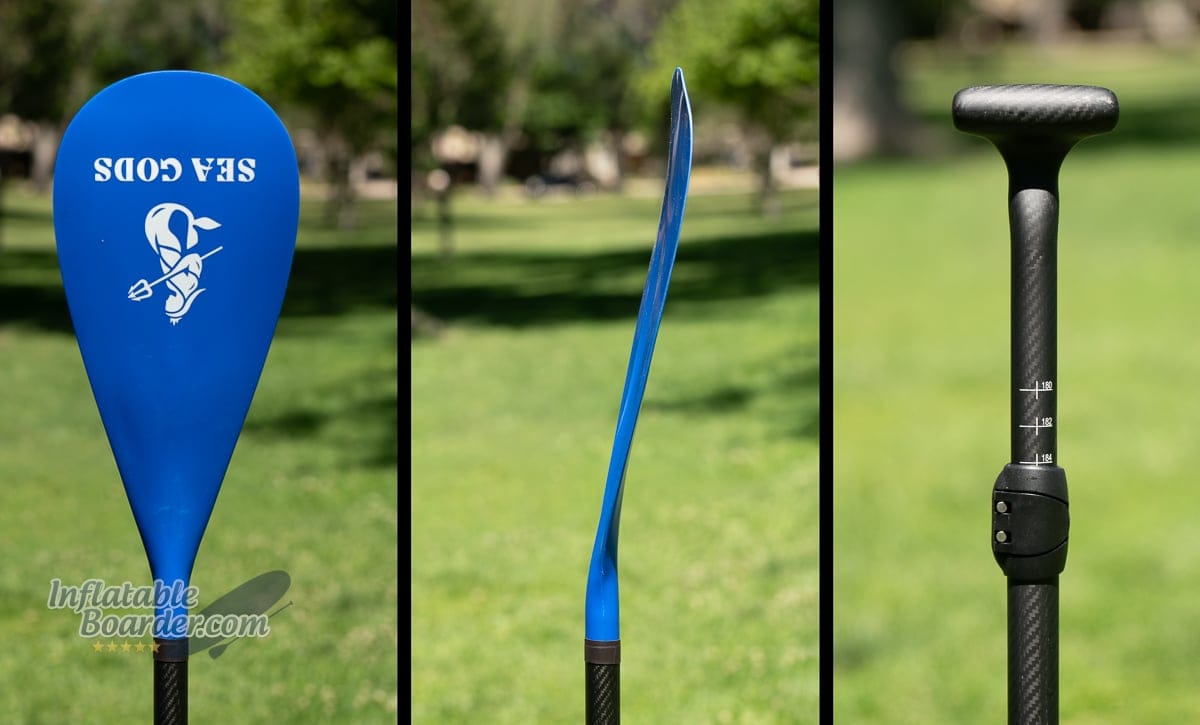
The Diatom CX comes with Sea Gods’ carbon fiber three piece paddle. The moderately large paddle blade with a teardrop shape is great for cruising along on the Diatom. With the larger blade shape you can easily propel yourself along with just a couple of paddle strokes. While the paddle shaft is carbon fiber, the blade is made of a reinforced nylon material that flexes in the water just enough to keep you comfortably paddling for long periods of time. I did notice that the blade was flexing significantly while speed testing the Diatom CX, however I don’t consider this to be a typical use for this board or paddle.
The carbon fiber paddle shaft is lightweight and also offers a moderate amount of stiffness. There is a compression clamp on the lower end of the shaft to prevent the blade from having any amount of play or wiggle as you paddle. The handle section has a length scale on the front and an indexing groove on the back. The indexing groove helps you align the handle and blade properly. I did have an issue with one paddle being misaligned, however the paddles are covered under Sea Gods’ warranty, so if you do run into an alignment issue contact Sea Gods for a replacement.
I’m a big fan of the molded T-grip handle on this paddle. Molded handles are definitely a premium feature and not often seen on kit paddles. It’s very comfortable to hold, has plenty of room for your fingers, and offers a very secure grip without the need for rough textures.
Stability
The wide outline and rigid construction of the Diatom Ten6 CX provides excellent stability for newer paddlers, larger paddlers, paddling with passengers, or just cruising around.
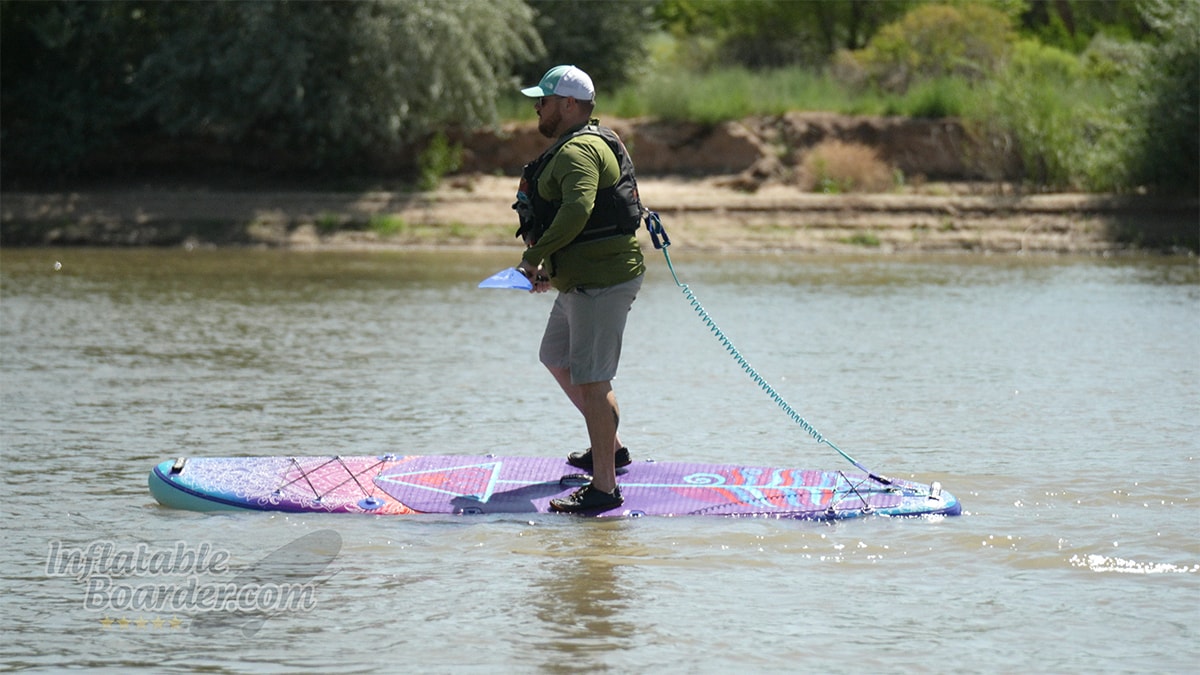
At 34” wide the Diatom Ten6 CX is definitely made for stability. The width of the board is carried very far forward to an extremely wide (almost 23”) nose and a moderately wide tail. This particular shape does a great job of keeping the Diatom CX stable while standing and paddling on the board, and for carrying cargo or a passenger toward the front of the board.
The tapering of the tail to a near pin-tail shape does change things up as you move backward on the board, though. As you walk back to the tail you can feel how the stability changes with each step. With the diminished tail under water you can very easily spin the Diatom CX around for a quick pivot turn, but you do need to keep your wits about you as the lower volume can sometimes feel a little squirrely until you shift your weight back toward the middle of the board.
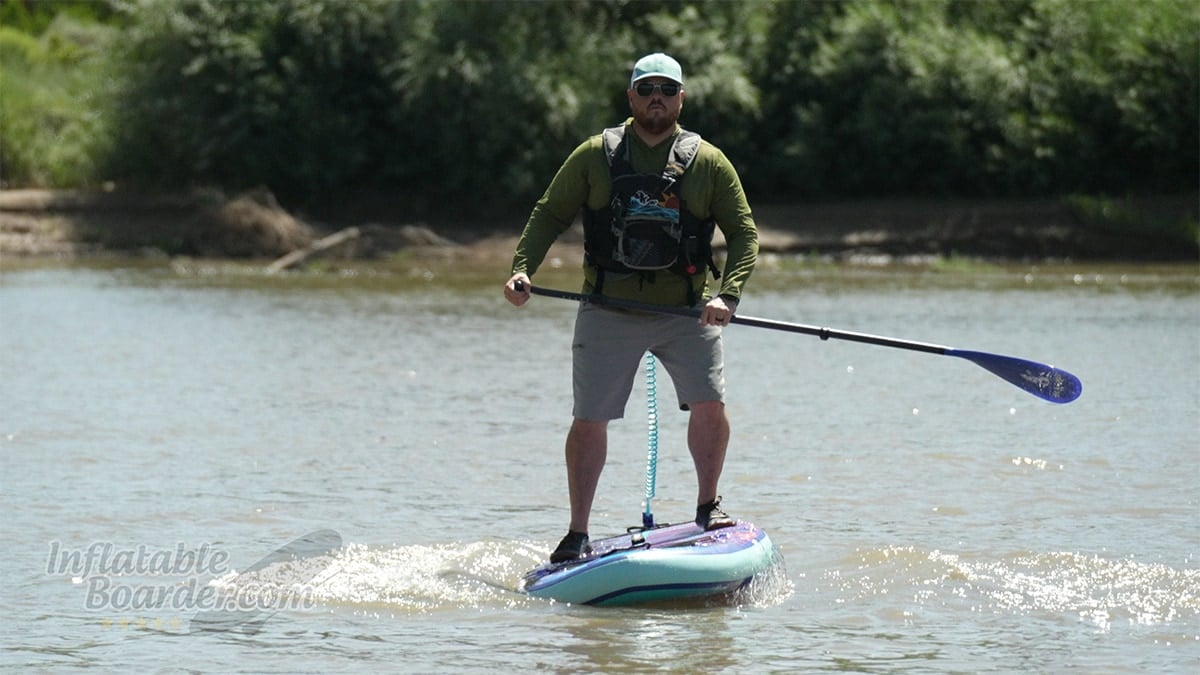
Once you are back to the typical standing area of the board, though, the Diatom CX becomes extremely stable once again. While rocking the board from side to side, even in the current of a river, I didn’t notice the board catching or twitching, but was very predictable and easy to recover and balance.
Overall the Diatom Ten6 CX has excellent stability that’s very suitable for beginner paddlers, larger paddlers, or those carrying some extra cargo or passengers.
Speed
While the Diatom Ten6 CX is very stable it does run into a few issues when trying to paddle at very high speeds. However it still feels great to paddle at cruising speeds and carries itself easily across the water.
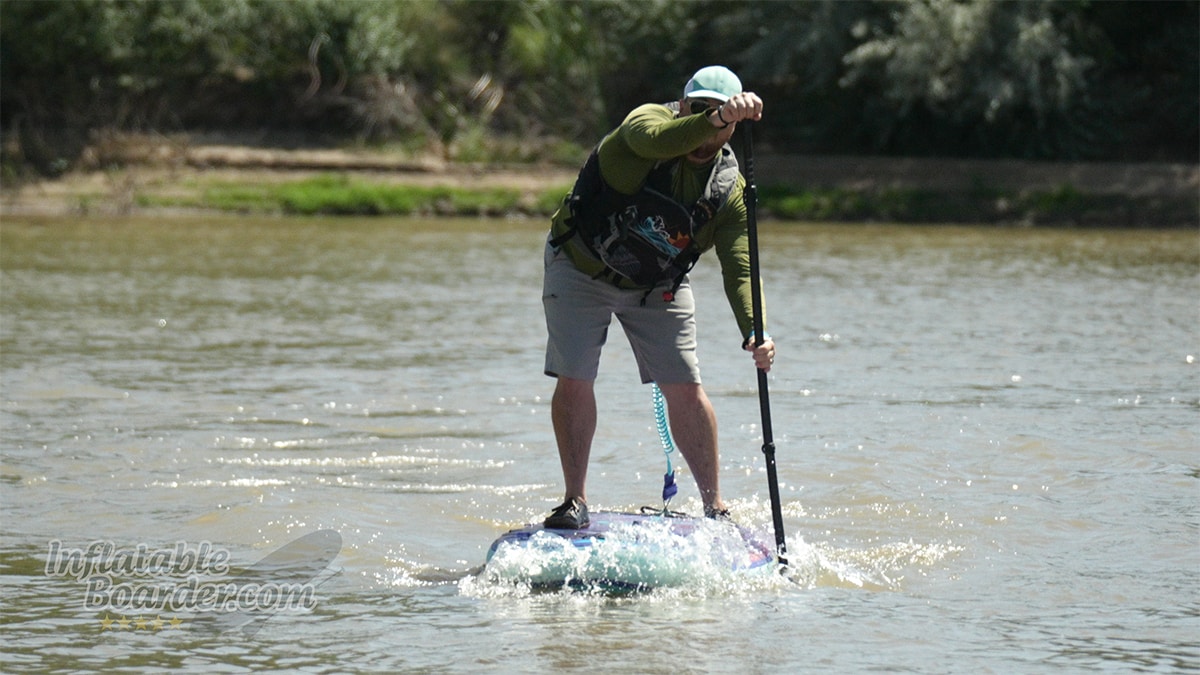
While speed testing the Diatom CX I could tell that the board felt out of its element. This cruiser-style all-around isn’t meant for racing, and that’s OK. The rigid construction still held up well to fast paddling without causing the board to bend and flex, however the lower rocker profile and wide nose did cause the board to noticeably plow its way through the water at higher speeds.
In our top-speed and sprint testing the Diatom CX performed about how I expected it to. The average sprint speed hovered around 5.0 MPH while the peak speed I was able to reach was just 5.5 MPH. These results are a little bit slow for other 34” wide boards, however most of those are a foot longer, which can make a big difference in their maximum speeds. Another component of this slightly slower speed is the flexibility of the paddle. The Sea Gods paddle is great for lower-cadence cruising, but does noticeably flex when putting down significant amounts of power.
Once I dialed things back to a more reasonable pace, the Diatom CX started performing much more comfortably. At a comfortable cruising pace of 25 strokes per minute the Diatom CX held an average 3.4 MPH and the feeling of pushing water was greatly reduced. The Diatom CX is also pretty efficient on the water. Between paddle strokes I was able to move just over 18 feet before feeling the board slow down, giving the Diatom CX a glide ratio of 1.7 board-lengths per stroke. That’s on the upper end of efficiency for all-around iSUPs, especially shorter and wider boards like the Diatom CX.
While I’m not going to pick the Diatom Ten6 CX for my next race, it still has plenty to offer for paddling efficiently over long distances.
Maneuverability and Tracking
The Diatom Ten6 CX has a classic cruiser shape and vibe. It’s highly maneuverable (great for paddling around your local waters or catching a wave) but does struggle when it comes to tracking straight over longer distances.
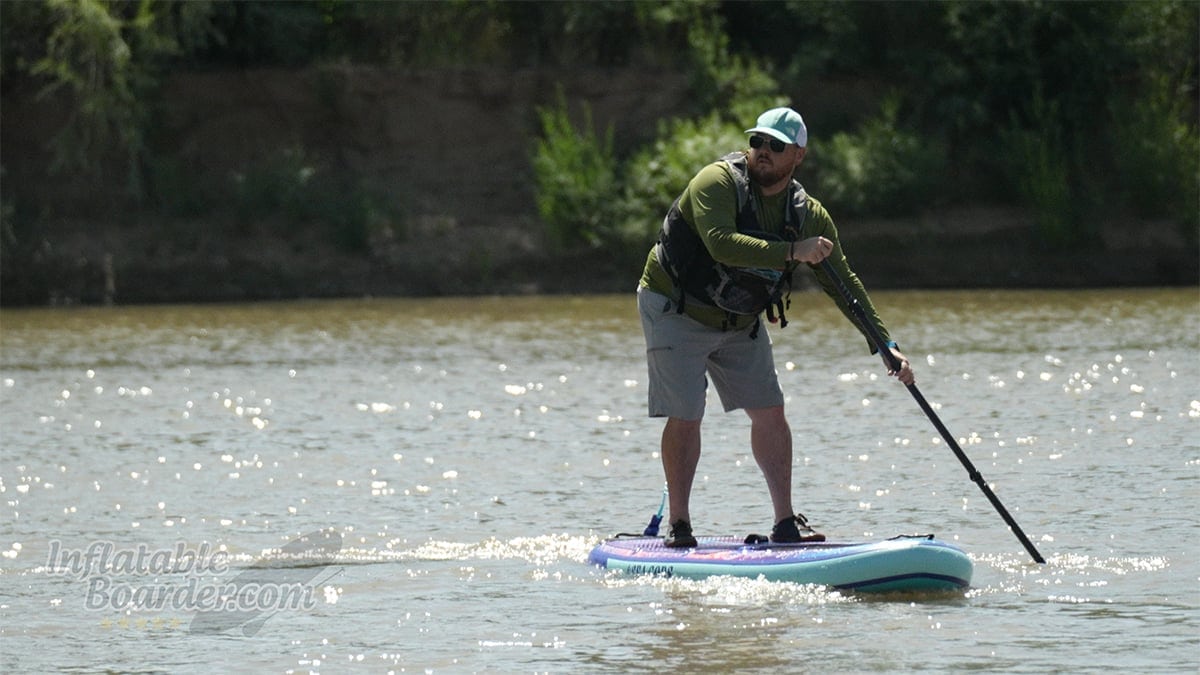
Our maneuverability test is designed to stress paddle boards to really find the strengths and weaknesses of different boards. By testing using less-efficient turning techniques (forward sweep strokes) we can really easily see which boards are easier to turn and which are harder to turn. Someone forgot to give that message to the Diatom Ten6 CX, because it just crushed our maneuverability test like a Sumo wrestler squeezing a juice box.
With forward sweep strokes (arguably one of the slowest ways to turn your board) the Diatom CX whipped around in a full circle with just 4.5 strokes. While that’s just under 90° per stroke on average, the reality was the first stroke got you well past 90°, you’ve done a complete U-turn before your second stroke is done, and that’s about the time when the fin begins to kick in and slows down your turn rate.
Reversing the test (with reverse sweep strokes) is even quicker and doesn’t even take 4 strokes to turn in a complete circle. Of course there are even faster methods of turning your board (like a pivot turn), but with maneuverability like this you hardly even need it!
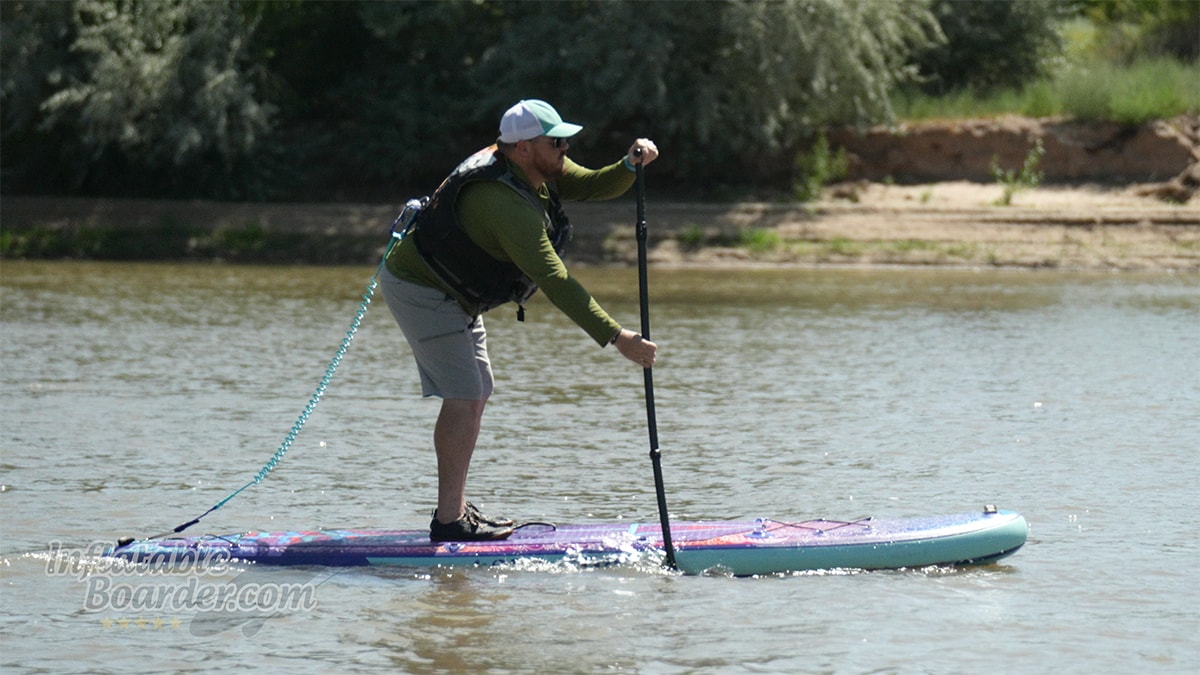
Even before I officially began testing the Diatom CX’s tracking ability I knew it wasn’t going to be great. While paddling around getting a feel for the board it was the one thing that kept popping into my head. Between the board’s size, the fin placement, and the fin itself, the Diatom Ten6 CX struggles to track in a straight line.
In our 10-stroke tracking test we paddle toward a distant target then take 10 strokes on a single side of the board and measure the difference between the original target and the board’s new course using a sighting compass. The Diatom CX deviated off course an average of 32° in our testing. That, unfortunately, puts it at the bottom of the list for tracking performance that we’ve tested.
Why is this? Well, I feel that it’s a combination of factors. First the Diatom CX is a shorter, wider board. This already puts it at a disadvantage for tracking compared to longer, narrower boards as it forces your paddle to be farther away from the centerline and there is less board length to resist turning. Next is the fin and fin placement.
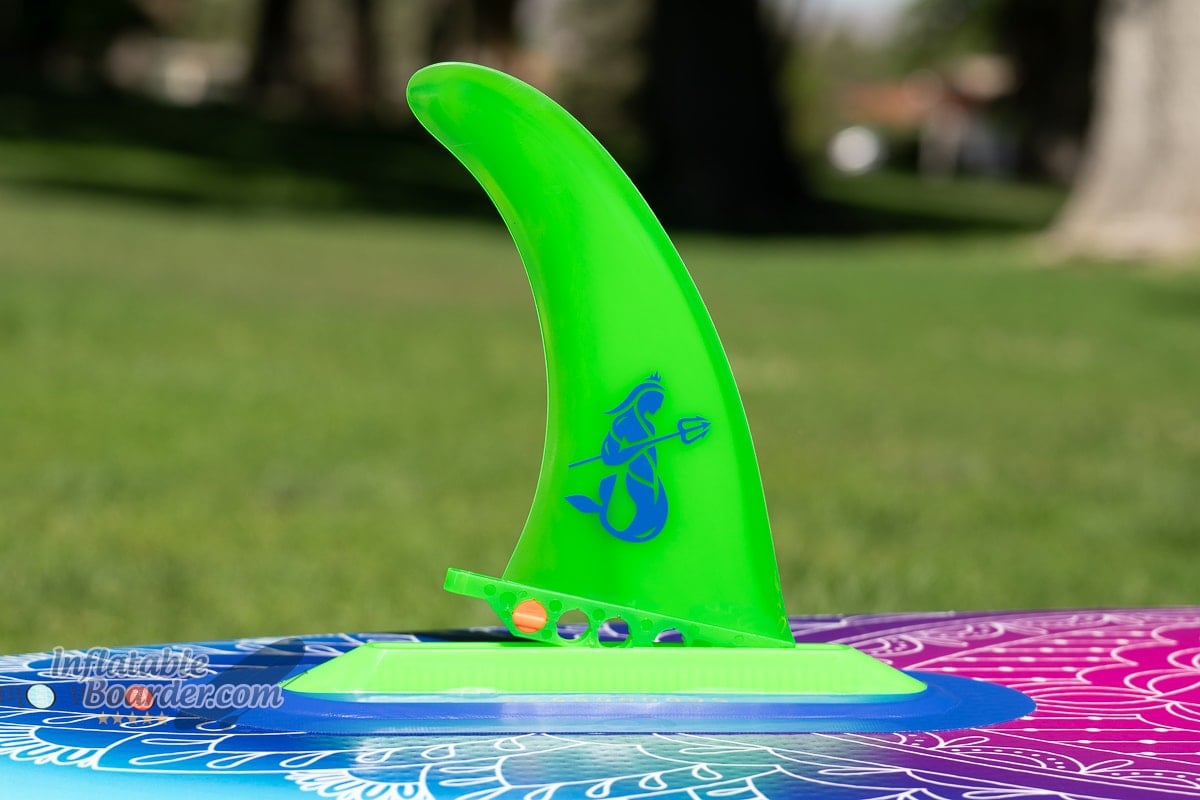
The Diatom Ten6 CX comes with a 9” surf-style/all-around flex fin. This shape is pretty standard for all-around paddle boards, and there’s nothing inherently wrong with it, but the combination of the fin, material, placement, and board shape make tracking more difficult. This style of fin is designed to provide more maneuverability. The flexible material of the fin also has a lower resistance in the water which allows the board to more easily turn. There are a few things you can do, and a few things Sea Gods could do to improve the tracking performance of the Diatom Ten6 CX. The first is fin selection. WIth a standard US fin box you can easily replace the stock fin with a different shape. A broader fin with more rake angle (how far back the fin “points”) will help improve tracking. Sea Gods does have this option available (it comes standard with their longer boards like the Skylla and Carta Marina CX). The next would be to use a stiffer fin that won’t flex in the water. Lastly, the fin box doesn’t allow for much variation in fin placement. A longer fin box or shifting the fin box slightly toward the tail would help increase the tracking ability of the Diatom Ten6 CX. While these would also reduce the board’s maneuverability, it could be done in such a way that better balances the two performance characteristics without losing the agility of the current setup.
Warranty and Customer Support
Sea Gods is one of the few paddle board companies that believes in their iSUPs so much that they offer a lifetime warranty against manufacturing defects. They also offer a repair service for non-manufacturing issues that may arise. Additionally, Sea Gods warranties all of their accessories for 1 year. This includes their paddles, pumps, fins, leashes, and more. Lastly, if you do decide that the Diatom Ten6 CX isn’t right for you, there is a 30-day return period, less shipping and a 10% restocking fee. If you do have any questions or concerns you can easily reach Sea Gods via their website, email, phone, or social media.
Overall Impressions/Review Summary
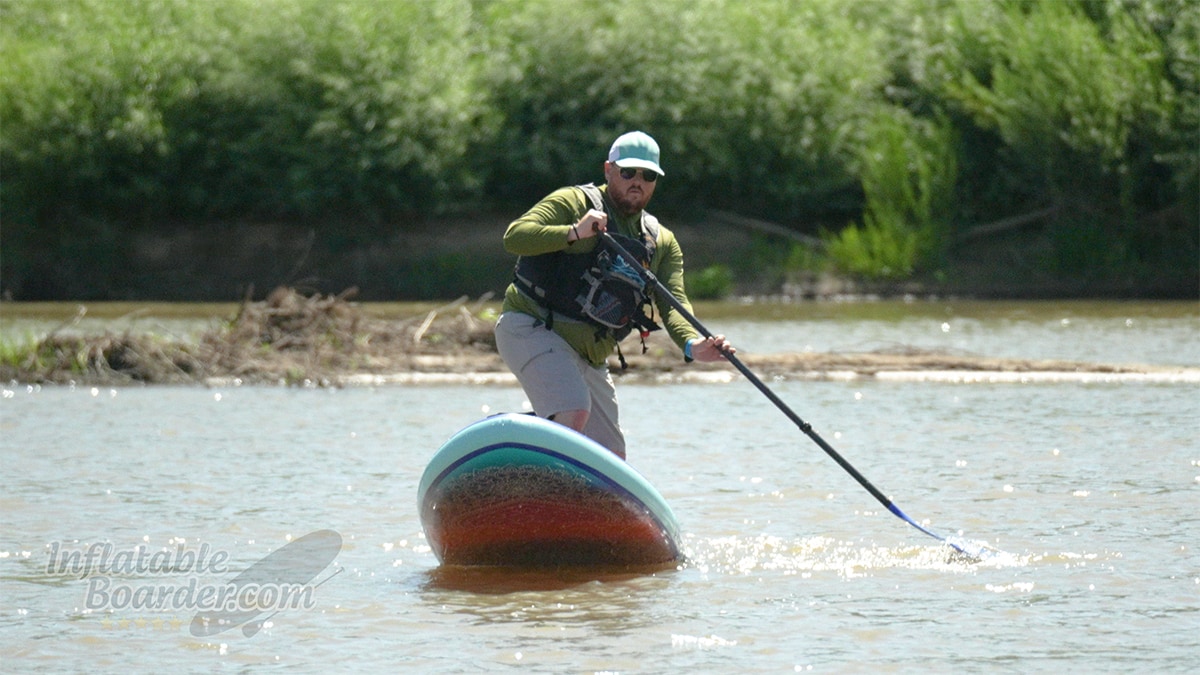
I really like the Sea Gods Diatom Ten6 CX. The design is breathtaking and the board is a blast to paddle. It’s a fantastic cruiser-style iSUP and is one of my go-to boards when I bring beginners on the water. The stable and agile performance is easy to get acquainted with, though it is sometimes hard to stop looking down at the artwork on the board! If you are looking for a fun-paddling, high-quality, buy-it-for-life iSUP that can easily double as a piece of art hanging on the wall behind your couch between paddle sessions, the Diatom Ten6 CX is right for you.
Sea Gods Diatom Ten6 CX iSUP FAQ
What is the difference between the Diatom Ten6 CX and Diatom Ten6 ULF
Both boards are made with an ultralight fusion PVC shell, however the CX technology incorporates a woven fabric base layer and crossed-stitch drop stitching inside the board to reduce weight without reducing rigidity. The CX version is roughly 5 lbs lighter than the ULF version. The CX version also comes with a higher-efficiency double chamber/triple action hand pump.
Can I paddle with a passenger or pet on the Diatom Ten6 CX?
Absolutely. The Diatom’s stable shape, rigid construction, and high weight capacity make it easy to paddle with passengers and pets.
Is the Diatom Ten6 CX compatible with a kayak seat?
It is. The Diatom Ten6 CX has four D-rings specifically placed to be compatible with the Sea Gods kayak seat. The included three piece paddle can also easily be converted to a double-bladed kayak paddle with the optional second blade.
How long does it take to inflate the Diatom Ten6 CX?
It only takes about 8 minutes to inflate the Diatom Ten6 CX to 15 PSI with the included triple-action hand pump, and only a few more minutes to reach the maximum 20 PSI.
How do I care for my Sea Gods Diatom Ten6 CX iSUP?
First it’s important to treat your board well by never dragging it on the ground and being careful to avoid impacts with potentially sharp objects (this happens most frequently while launching or landing). Avoid overpressurization or damage from excessive heat - keep your board in the water or partially deflated when out of the water. Next keep your board clean by rinsing it with fresh water between uses and removing any dirt, algae, or other substances. Always fully dry your board before storing it. Keep your board stored in a dry location out of direct sunlight.
Is the Sea Gods Diatom Ten6 CX worth the cost?
Absolutely. The Sea Gods Diatom Ten6 CX is a fantastic all-around iSUP adorned with gallery-quality artwork. It’s built using advanced materials and processes and is backed by a lifetime warranty - something that very few iSUPs can boast.
